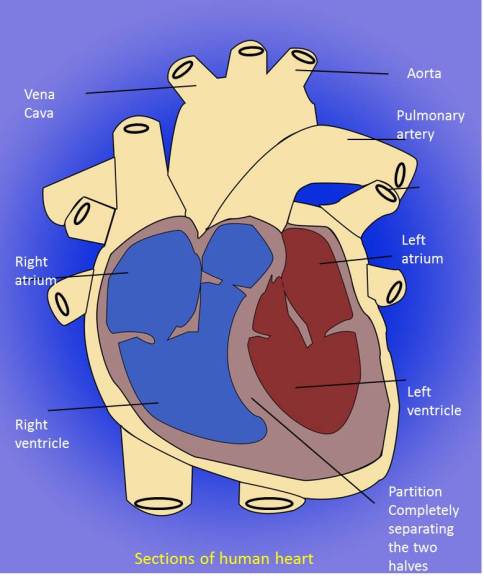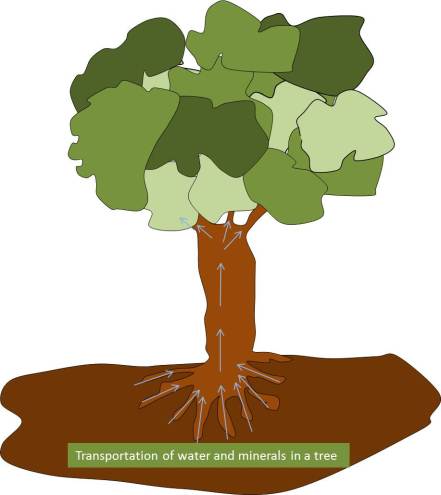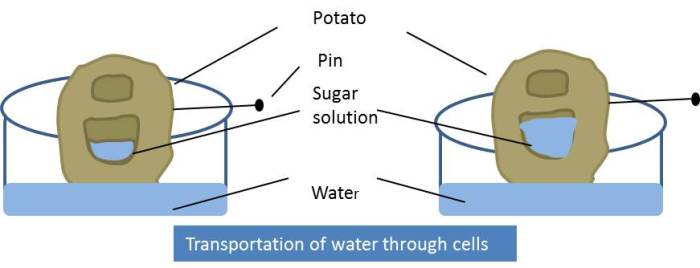Notes of chapter: Transportation in Animals and Plants are presented below. Indepth notes along with worksheets and NCERT Solutions for Class 7.
(1) Circulatory system –
Circulatory system of human consists of heart, blood and blood vessels which transports blood in throughout the body.
Organs of circulatory system-
(i) Blood-
Blood is a fluid which consists of plasma, blood cells, platelets, flows in blood vessels and transports oxygen, carbon die oxide, digested food from the small intestine to other part of body and remove waste from the all body tissues.
(a) Plasma-
The colourless fluid part of blood is called plasma.
(b) Red blood cells-
Red blood cells (RBC) which find in blood contain a red pigment called haemoglobin.
(A) Haemoglobin binds with oxygen and transports it to all the part of the body and ultimately to all cells.
(B) The presence of haemoglobin makes blood appear red.
(c) White blood cells-
White blood cells find in blood which fights against germs that may enter our body.
(d) Platelets-
Platelets are the blood cells which help in forming clot at the time of bleeding.
(ii) Arteries and veins-
There are two types of blood vessels presents in our body, i.e., arteries and veins.
(a) Arteries-
Arteries are the vessels which carry oxygen rich blood from the heart to all parts of the body. Since the blood flow is rapid and at a high pressure, the arteries have thick elastic walls.
Experiment 1
Place the middle and index finger of your right hand on the inner side of your left wrist. You feel throbbing which is happen due to blood flowing in the arteries. This throbbing is called pulse. Thus, pulse is throbbing of arteries as blood is flowing in them and can feel it in wrist and neck.
The number of beats per minute is called the pulse rate. A resting person has a pulse rate between 72 and 80 beats per minute.
Pulse rate
| S. No. | Name | Pulse per minute |
| 1. | Ramesh | 72 |
| 2. | Neeta | 74 |
| 3. | Adhar | 72 |
| 4. | Smay | 75 |
| 5. | Reena | 75 |
(b) Veins-
Veins are the vessels which carry carbon dioxide rich blood from all parts of the body back to the heart. The veins have thin walls. There are valves present in veins which allow blood to flow only towards the heart.
(c) Capillaries-
On reaching the tissues, arteries further divide into extremely thin tubes called capillaries. Thus capillaries are the blood vessels which are formed by the further division of arteries and make a network between arteries and veins.

(iii) Heart-
The heart is an organ which beats continuously to act as a pump for the transport of blood, which carries other substances with it.
(a) The heart is located in the chest cavity with its lower tip slightly tilted towards ahe left.
(b) The heart has four chambers. The two upper chambers are called the atria and the two lower chambers are called ventricles. The partition between the chambers helps to avoid mixing up of blood rich in oxygen with the blood rich in carbon dioxide.
(c) The right side of heart carries de oxygenated blood which enters into right atrium and then to right ventricle. This blood is then pumped to lungs via pulmonary artery. The left side of heart carries oxygenated blood which enters from lungs through pulmonary vein. It passes to left atrium then it passes to left ventricle. From here it pumped to aorta to deliver in whole body.

(iv) Heart beat-
The rhythmic contraction of muscles of walls of the chambers of the heart followed by its relaxation constitutes a heart beat.
(a) A doctor uses the stethoscope as a device to amplify the sound of the heart. It consists of a chest piece that has a sensitive diaphragm, two ear pieces and a tube joining the parts.

Experiment 2
Take a funnel of 6-7 cm in diameter. Fix a rubber tube of 50 cm long tightly on the stem of the funnel. Take a rubber sheet or balloon and fix it on the mouth of the funnel firmly. Place the mouth of the funnel on your chest and keep other end of the tube at your ear. Try to hear heartbeat.

Heartbeat and pulse rate
| Name of the student | Heartbeat while resting | Pulse rate while resting | Heartbeat after running (4-5 minutes) | Pulse rate after running ( 4-5 minutes) |
| Ramesh | 72 | 72 | 97 | 97 |
| Adhar | 74 | 74 | 100 | 100 |
| Radha | 76 | 76 | 105 | 105 |
| Seema | 75 | 75 | 99 | 99 |
| Atul | 75 | 75 | 100 | 100 |
Each heart beat generates one pulse in the arteries and the pulse rate per minute indicates the rate of heart beat.
(b) The rhythmic beating of the various chambers of the heart maintains circulation of blood and transport of substances to the different parts of the body.
(c) Animals such as sponge and hydra do not posses any circulatory system. The water in which they live brings food and oxygen as it enters their bodies. The water carries away waste materials and carbon dioxide as it moves out. So, they do not need a circulatory fluid like the blood.
(d) The English physician, William Harvey discovered the circulation of blood.
(2) Excretion-
The process of removal of wastes produced in the cells of living organisms is called excretion.
The parts of body like kidneys, ureters, bladder and urethra which involved in excretion forms the excretory system.

Organs of excretion system-
(i) Kidneys-
The blood having useful and harmful substances is filtered by the blood capillaries in the kidneys.
(ii) Urethra-
The waste dissolved in the water is removed as urine. From the kidneys, urine goes in to urinary bladder through tube like ureters. It is stored in the bladder and is passed out through the urinary opening at the end of a muscular tube called urethra.
An adult human normally passes about 1 – 1.8l of urine in 24 hours. The urine consists of 95% water, 2.5% urea and 2.5% other waste products.
(3)The sweat contains water and salt which left white marks on our clothes. Sweat evaporates from our body which keeps us cool in summer. Same process is followed in the earthen pot to keep water cool.
(4) Aquatic animals –
Aquatic animals like fish excrete cell waste as ammonia which directly dissolves in water.
(5) Land animals-
Some land animals like lizards, birds, snakes excrete a semi solid, white coloured compound (uric acid).
(6) Dialysis-
When a person’s kidney fails waste products starts accumulating in the blood. These waste materials should be remove from the patients .Thus, the process in which blood filtration periodically is done by artificial kidney is called dialysis.
(7) Transport of substances in plants-
(i)Transport of water and minerals-
(a) Root hair-
Root hair of roots increase the surface area of the root for the absorption of water and mineral nutrients dissolved in water.

(b) Tissue-
The vessels of plants transport water and nutrients from the soil. They are made of special cells, forming the vascular tissue.
A tissue is a group of cells that perform specialized function in an organism.
(c) Xylem-
The vascular tissue for the transport of water and nutrients in the plant is called the xylem. It connects the roots to the leaves through the stem and branches and thus transports water to eh entire plant.

(d) Pholem-
Pholem is the vascular tissue which transport food to all parts of the plant.
Experiment 3
Take a large potato peel it. Cut one of its ends to make the base flat. Now make a cavity on the opposite side. Fill half of the cavity with sugar solution and mark the level by inserting a pin in the wall of the potato. Put the potato into a dish containing a small amount of water which should be lower than level of the pin. After few hours, you will find an increase in level of sugar solution. Water moves from one cell to another. In the same way water reaches xylem vessels of the root from the soil.

(ii) Transpiration-
Transpiration is the process in which water evaporates through the stomata present on the surface of the leaves. Transpiration generates a force which pulls up water absorbed by the roots from the soil, to reach the stem and leaves.
Helping Topics